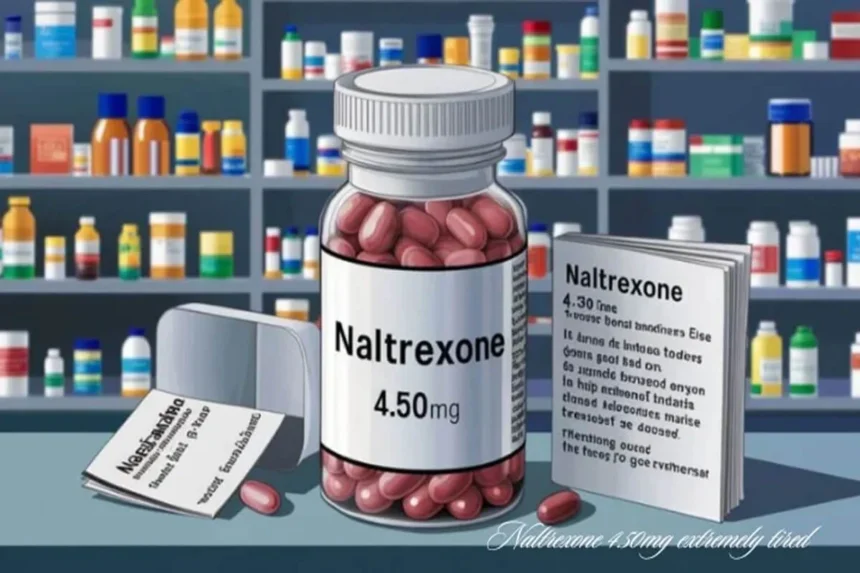Introduction
naltrexone 4.50mg extremely tired , especially in the low-dose form (4.50mg), has gained attention for its wide range of applications, particularly for chronic conditions like autoimmune diseases, fibromyalgia, and even mental health disorders. Despite its potential benefits, many users report experiencing extreme fatigue when taking this medication. Understanding the causes and management of this side effect is crucial for those seeking relief through naltrexone therapy.
In this article, we will delve into:
- The relationship between naltrexone 4.50mg extremely tired and fatigue
- How common this side effect is
- Why this happens and what can be done to manage it
- The importance of discussing side effects with a healthcare provider
Let’s explore the causes of fatigue, its potential impacts, and practical solutions to ensure patients can maximize the benefits of low-dose naltrexone (LDN) therapy.
What is Naltrexone?
naltrexone 4.50mg extremely tired is an opioid antagonist that was initially developed to treat opioid and alcohol dependence. However, at lower doses (such as 4.50mg), it is used off-label to manage various conditions like multiple sclerosis (MS), Crohn’s disease, and even some cancers. The low-dose form works by modulating the immune system and reducing inflammation.
The Mechanism of Action
At low doses, naltrexone 4.50mg extremely tired temporarily blocks opioid receptors, leading to a short-term increase in endorphin production. Endorphins, the body’s natural painkillers, are known to improve mood, reduce inflammation, and regulate the immune system. However, despite these benefits, some users report feeling extremely tired or fatigued, especially when they first begin taking the drug.
Fatigue and naltrexone 4.50mg extremely tired : A Common Side Effect?
Many people who start taking naltrexone at 4.50mg report feeling tired, especially in the early stages of treatment. While naltrexone is generally well-tolerated, fatigue appears to be one of the more commonly reported side effects. A 2019 study in Clinical Therapeutics found that approximately 18% of patients on low-dose naltrexone reported fatigue as a side effect during the initial phase of treatment.
Statistical Overview of Side Effects
- Fatigue: As mentioned, 18% of low-dose naltrexone users experience fatigue.
- Sleep disturbances: Approximately 10-15% of patients report issues with sleep, which could further contribute to tiredness.
- Mild flu-like symptoms: Up to 12% of patients report flu-like symptoms during the first few weeks of naltrexone therapy.
These statistics suggest that while fatigue is a relatively common side effect, it often resolves as the body adjusts to the medication.
Why Does Naltrexone Cause Fatigue?
Fatigue is a complex symptom that can have multiple underlying causes. In the case of low-dose naltrexone 4.50mg extremely tired, the fatigue experienced by some users may be related to the following factors:
- Adjustment Period
When patients first start taking naltrexone, their bodies may need time to adjust to the medication’s effects. During this period, the sudden increase in endorphin production could cause temporary fatigue as the body adapts to the new equilibrium. - Interaction with the Immune System
Since naltrexone modulates the immune system, patients with autoimmune conditions may experience changes in energy levels as their immune system responds to the medication. In some cases, this can lead to feelings of exhaustion or fatigue. - Detoxification and Healing
For patients with chronic illnesses, naltrexone may initiate a healing process that puts additional stress on the body. As the medication helps to regulate immune function, it may trigger detoxification processes that leave patients feeling drained. - Sleep Disruption
Some patients report that naltrexone affects their sleep patterns, leading to insomnia or restless sleep. Poor-quality sleep can contribute to fatigue during the day. - Individual Response
Everyone responds differently to medications, and factors such as dosage, timing, and individual health conditions can all influence the side effects experienced. Some individuals may be more sensitive to the drug’s effects on the central nervous system, which could result in fatigue.
You may also like: https://sitthemoon.com/i-became-a-crazy-swordsmanship-instructor-in-the-game/
How to Manage Fatigue Caused by Naltrexone 4.50mg
If you are experiencing extreme tiredness while taking naltrexone 4.50mg, there are several strategies you can consider to manage this side effect:
1. Timing of the Dose
- Take Naltrexone at Night: Many patients find that taking naltrexone before bed helps to minimize daytime fatigue. Since fatigue is a common side effect, taking the medication at night allows your body to rest while adjusting to the drug.
2. Gradual Dose Adjustment
- Start at a Lower Dose: Some healthcare providers recommend starting at a lower dose (e.g., 1.50mg or 3.00mg) and gradually increasing to 4.50mg over time. This can help your body adjust more slowly and may reduce the severity of side effects like fatigue.
3. Improve Sleep Hygiene
- Optimize Sleep Environment: Ensuring that you have a comfortable sleep environment, maintaining a consistent sleep schedule, and practicing relaxation techniques can improve your sleep quality, which may help reduce fatigue.
- Consider Melatonin: If naltrexone disrupts your sleep, some patients find relief by taking a melatonin supplement, which can help regulate sleep patterns.
4. Increase Physical Activity
- Exercise: Regular, moderate exercise is proven to boost energy levels and reduce feelings of fatigue. Gentle activities like walking, yoga, or stretching can help improve overall energy without exacerbating fatigue.
5. Hydration and Nutrition
- Stay Hydrated: Dehydration can exacerbate feelings of tiredness. Drinking enough water throughout the day is crucial when taking any medication.
- Balanced Diet: Consuming a diet rich in vitamins, minerals, and antioxidants can support your body’s healing process and provide the energy needed to combat fatigue. Consider incorporating foods like leafy greens, berries, and whole grains into your meals.
Importance and Benefits of Naltrexone 4.50mg Despite Fatigue
Even though fatigue can be a challenging side effect, it’s essential to recognize the many benefits that low-dose naltrexone (LDN) can provide. For patients with chronic illnesses or autoimmune conditions, LDN offers several key advantages:
- Reduction in Chronic Pain
Many patients taking LDN report a significant reduction in chronic pain levels, particularly those with conditions like fibromyalgia, rheumatoid arthritis, and Crohn’s disease. This improvement in pain management can greatly enhance quality of life, even if fatigue is a temporary side effect. - Improved Immune Function
By modulating the immune system, naltrexone can help to reduce inflammation and manage autoimmune conditions like multiple sclerosis (MS) and Hashimoto’s thyroiditis. Patients often experience fewer flare-ups and a stabilization of their symptoms over time. - Mental Health Benefits
Low-dose naltrexone has been shown to improve mood and alleviate symptoms of depression in some patients. For individuals dealing with both physical and mental health challenges, the mood-enhancing effects of LDN can be life-changing. - Minimal Long-Term Side Effects
Unlike some other medications, low-dose naltrexone tends to have minimal long-term side effects, and many patients find that fatigue subsides after the initial adjustment period. Once the body adapts, most users report feeling more energized and healthier overall.
Applications and Use Cases: Real-World Examples of Naltrexone Success
Case Study 1: Fibromyalgia
A 2014 study published in Arthritis & Rheumatism found that low-dose naltrexone reduced pain levels in fibromyalgia patients by approximately 30%. While some patients reported fatigue during the first few weeks, this side effect typically diminished, and patients experienced significant improvements in pain and overall quality of life.
Case Study 2: Crohn’s Disease
In a 2018 clinical trial, Crohn’s disease patients taking low-dose naltrexone saw a reduction in disease activity and inflammation. Although fatigue was reported by some participants, the overall benefits in terms of reduced intestinal inflammation and improved symptom control outweighed the temporary tiredness.
Challenges and Solutions in Using Naltrexone 4.50mg
Challenge 1: Long-Term Fatigue
While fatigue usually resolves within a few weeks, some patients may continue to feel tired for an extended period.
Solution: If fatigue persists, consult your healthcare provider. Adjusting the dosage, changing the timing of the dose, or incorporating lifestyle changes (like those mentioned earlier) can help mitigate this issue.
Challenge 2: Medication Adherence
Fatigue can make it challenging for patients to stick to their treatment regimen, especially if they are struggling with low energy.
Solution: Patience is key. Most side effects, including fatigue, are temporary. Ensure open communication with your healthcare provider to adjust your treatment plan as necessary.
Conclusion
While fatigue is a common side effect of taking naltrexone 4.50mg, it is often temporary and manageable. For patients seeking relief from chronic pain, autoimmune conditions, and mood disorders, the benefits of this medication generally outweigh the initial discomfort of feeling extremely tired. By understanding the causes of fatigue, making lifestyle adjustments, and working closely with a healthcare provider.










